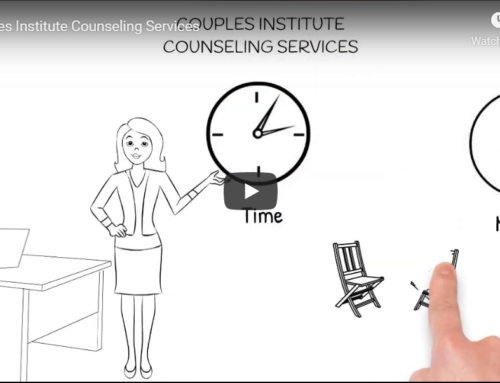Previously, we presented the first six steps to telling the truth with your partner, even when it’s on a difficult or touchy subject. To review the article, where the steps are described in more detail, click here
- Make the decision to be truthful.
- Decide what you want to happen.
- Explore your own avoidance.
- Set a time and a place.
- Don’t be passive aggressive.
- Plan what you will say or do.
This month we’ll pick up where we left off. Tina’s been preparing to bring up the difficult subject of faking orgasms with her husband Tom. It’s finally time to start the conversation she’s been thinking about. Here are some pointers about the dialogue along with another option, writing down your thoughts.
STEP 7: START THE CONVERSATION
Tina says something like, “Tom, I want to talk to you about something difficult. It’s kind of scary for me to talk about it. I know you may think I’m blaming you. Could you do your best to listen without feeling like I’m attacking you or that it’s your fault?”
Give a warning that you’re going to say some things that may be difficult to hear. Ask your partner to listen to you all the way through, assuring him that you’ll respond to him afterward.
You can alert him to what he might feel about the topic so he’s less likely to be caught off guard and can steady himself. This also demonstrates that you take his feelings seriously. If your partner isn’t ready to talk, ask when he might be.
STEP 8: TAKE RESPONSIBILITY FOR WHAT YOU’VE DONE
Tina might say, “I want you to know that I’ve only been pretending to have orgasms. I know I’ve given you some mixed signals over the years. I gave the impression that I was wowed by your lovemaking so as not to make you feel bad, but I’ve been faking it. I’m bringing this up so that we can do something to change our physical relationship so that it works for both of us.”
During this part of the process it’s important to do the following things:
1. Acknowledge that what you say might seem like an l80-degree turn.
2. Resist demanding an immediate response. Sometimes the truth teller wants reassurance from the other person that everything’s still okay. For instance, Tina might say, “But I still want to know that you find me physically attractive and that this won’t change any of your feelings about me.” That’s asking for reassurance when your partner wants time to register what you’ve said.
3. Avoid defensive patterns. Some people blame the other or make up excuses even as they speak. This is your moment to come clean. Do it right.
4. Be open. You must be receptive to knowing more about yourself than when you started. This openness allows you to be a good truth teller. Tina could say, “I should have told you sooner. I’ve been rationalizing that I’ve been doing this for you, so you’d think I was satisfied, but I know I have my hang-ups and inhibitions. Sex isn’t an easy thing for me. I don’t know why I let it continue for so long. I guess I was just too afraid to say anything.”
5. Take responsibility for what has stopped you from revealing the truth earlier. If Tina was afraid to let Tom see that she didn’t feel comfortable talking about sex, she can say it.
6. Describe your own struggles with telling the truth. This helps your partner understand what’s happened in the context of your relationship. It will help him or her to see that your sentiments haven’t simply appeared out of nowhere. Tina says, “I know I should have told you sooner. I was hoping the situation would magically fix itself. It seemed easier to fake. Sometimes I was afraid of getting too carried away so I wanted to get it over with so I wouldn’t feel afraid.”
7. Be sensitive to your partner’s reaction but don’t use every hint of distress as a reason to bailout too soon. For example: Tom looks at Tina with sad eyes and says, “You’ve been what?” She says, “Uh, you know I must have faked it only about one or two times. It’s no big deal, just something I felt like telling you.” End of truth telling. End of any chance for change.
Here’s another way Tina could handle it: Tom looks at Tina with sad eyes and says, “You’ve been what?” She says, “For me not to tell you would be to demean you and me even more. I finally realized that by bringing it out in the open we could find a way to have a better physical relationship and enjoy each other more.”
STEP 9: AN OPTION–DO IT IN WRITING
Particularly when the truth involves some sensitive material, it may be helpful to write your partner a letter. The process of writing can clarify hat you want to communicate. Another benefit is that by writing it down you know you will hold your audience all the way through. When you just spontaneously talk, you encounter a lot of verbal interference. The truth teller is put in a position to defend himself. Even in a psychotherapist’s office, whoever’s hearing the truth will start rising out of the chair. Nobody puts down a letter to rant and rave the way they would with the person standing there. And while you can write a rough draft, you can’t do a rough cut for the live version.
When you commit your thoughts to paper, tell your partner the ambivalence you feel about telling the truth. Tina could write,”I have talked myself out of this before because I always said it wasn’t the right time,” or “I’ve felt too ashamed to admit this even to myself,” or “This is why it’s been hard for me.”
Self-disclosure softens the impact. A letter can be a catapult for understanding, giving your partner a larger context for what’s been going on. It can also help your own understanding because you can practice formulating your thoughts. You never actually have to give the letter to your partner.
Expressing your viewpoint isn’t simply a ploy to get your partner on your side. Imagine if you said, “I lied to you and don’t know why.” That will not inspire confidence. If you explain what you’ve experienced, your partner will have more to hold on to as he or she tries to understand what’s going on.
Most people do feel more comfortable expressing themselves in person, but you may find it helpful to tell your partner and have a written version. Your mate can ask, “What do you mean by this?” and you’ll have something to refer to. If you’re simply speaking and he says, “What do you mean by that?” you may dissolve into gibberish and watch your good intentions dissipate.
Suppose Tina had a really defensive and ugly initial response from Tom. “No woman ever says something like that to me!” Rather than drop it altogether, Tina could write down her thoughts to keep the issue alive until she feels they could deal with it.
We encourage you to think of some area of your behavior where you could be more truthful and use these nine steps to share it with your partner. It doesn’t have to be big. Even little steps towards truthfulness can help you build a closer relationship.
Ellyn Bader, Ph.D., is Co-Founder & Director of The Couples Institute and creator of The Developmental Model of Couples Therapy. Ellyn is widely recognized as an expert in couples therapy, and since 2006 she has led innovative online training programs for therapists. Professionals from around the world connect with her through internet, conference calls and blog discussions to study couples therapy.
Ellyn’s first book, “In Quest of the Mythical Mate,” won the Clark Vincent Award by the California Association of Marriage & Family Therapists for its outstanding contribution to the field of marital therapy and is now in its 18th printing. She has been featured on over 50 radio and television programs including “The Today Show” and “CBS Early Morning News,” and she has been quoted in many publications including “The New York Times,” “The Oprah Magazine” and “Cosmopolitan.”




